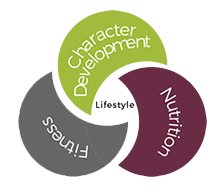Get on the Ball
By: Karla Adams, Lopergram
As an athlete, why get on the ball? Getting on the ball can help you reach any physical advancement goals you have as a runner/walker. How? A ball workout combines an unstable base of support (the ball) and a stable base of support (the floor). Exercising on an unstable base activates your deepest abdominal muscles (core stability), balance and proprioception (body awareness). Healthy deep abdominal muscles and back muscles support movement such as throwing, lifting or running. These deep abdominal muscles are required to support virtually every movement, even those that are not heavy or extreme. The importance of strong stabilizers is overlooked. These abdominal muscles cannot be worked by abdominal crunches alone. These muscles are challenged by creating an unstable base to work on.
Using the ball is a great way to transform your current weight training workout into a stabilizing weight training workout. Almost any exercise that you’re presently doing in the gym can be transformed into a stabilizer exercise. Along with the ball, there are other tools that can be used to challenge your stabilizers: disks and the medicine ball are great examples. Using different positions on these different tools allows you to work on stabilizing and strengthens different parts of your body. For example, sitting on the ball with your feet on the floor trains your lower back. You can also take it a step further and sit in the same position while doing lateral shoulder raises. Advancing it even further you would lift one leg (see picture) while doing your shoulder press. Working your stabilizers for 30-40 minutes, 2-3 times per week is a good base routine. Another example of making your normal workout a stability workout is standing on a disk while doing shoulder press or triceps extensions (see pictures). Any exercise, that you stand to perform, can be done on the disk. These great tools can take your workouts TO THE NEXT LEVEL.
When practicing a stabilizer workout, remember to “isolate” the target muscle while “balancing” yourself in “good posture”. Though all three are being performed simultaneously, they are all very different. When “isolating” a muscle, the work should be felt mostly, if not completely, in the desired muscle. When “balancing” you are strengthening mental focus. “Good posture” is necessary in the process of isolation and stabilizing in order to achieve the desired effect of the exercise. When lifting any weights, the goal should be to work a specific muscle or muscle group, not to just simply move the weight around. Anyone can “move a weight” for resistance training but, isolating a muscle, holding good posture all while trying to maintain balance, requires a lot of mind-to-muscle communication. You are “challenging” yourself mentally as well as physically. Strengthening your mind-to-muscle communication helps to give you more awareness and control over your body. Thus, improving physical activity from actions as simple as not bumping your hip as you move quickly around a desk to quick efficient movement during a race. Having more awareness and efficacy of movement helps to prevent injuries as well. Most injuries are accidental. Another benefit to strong stabilizers is keeping pain out of your lower back. The most common reason people have low back pain is because of weak stabilizers. Repeating a couple simple exercises each week can help keep you pain free.



